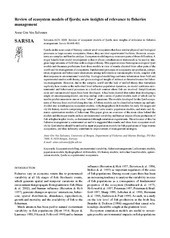Review of ecosystem models of fjords; new insights of relevance to fisheries management
Peer reviewed, Journal article
Published version
Permanent lenke
http://hdl.handle.net/1956/3866Utgivelsesdato
2001Metadata
Vis full innførselSamlinger
Sammendrag
Fjords on the west coast of Norway contain small ecosystems that have similar physical and biological processes as large oceanic ecosystems. Hence, they are ideal experimental facilities. However, ecosystems are complex and hard to analyse. Ecosystem modelling may overcome parts of these difficulties. A major benefit from model development is that it allows a mathematical framework to be used to integrate large amounts of field data with ecological theory. This paper reviews Norwegian ecological fjord models and discusses predictions from these models in view of results obtained from other parts of the world and for management of ecosystems. Fundamental processes in ecosystems are predation, competition, migration and behavioural interactions among individuals at various trophic levels, coupled with their response to environmental variability. Ecological modelling combines information from field and experimental studies with theory, and gives ecological insight of indirect or direct relevance for fisheries management. However, due to the complex world and the lack of unified theory that formulates explicitly how events at the individual level influence population dynamics, no model combines environmental and behavioural processes in a food-web context where fish are involved. Simplifications exist and various model types have been developed. It has been claimed that rather than developing a single all-encompassing model, one may end up with a series of partial models each of which can be used to predict answers to one or a few “what-if” questions. The models developed for the fjord ecosystems of Norway have evolved along this line. All these models can be classified as bottom-up and subdivided into i) multispecies ecosystem models; ii) hydrographical drift models for early life stages and iii) life history models comprising age-structured Leslie matrix population models, and static and dynamic optimisation models of behaviour. This paper gives an overview of the main ideas behind the models and the major results on how environmental variability and human impact affects production of fish at higher trophic levels, as demonstrated through simulation experiments. The relevance of this for fisheries management is commented on and it is suggested that results and ideas from ecosystem models for fjord studies should be utilized as input in population models for fish populations of large marine ecosystems, and thus indirectly contribute to improvement of management strategies.
Utgiver
The University of BergenOpphavsrett
This is an electronic version of an article published in 'Sarsia' © 2001. Copyright Taylor & Francis; 'Sarsia' is available online at http://www.informaworld.com/openurl?genre=journal&issn=1745-1000Beslektede innførsler
Viser innførsler beslektet ved tittel, forfatter og emneord.
-
Modeling of land–surface interactions in the PALM model system 6.0: land surface model description, first evaluation, and sensitivity to model parameters
Gehrke, Katrin Frieda; Sühring, Matthias; Maronga, Bjørn (Journal article; Peer reviewed, 2021)In this paper the land surface model embedded in the PALM model system is described and evaluated against in situ measurements at Cabauw, Netherlands. A total of 2 consecutive clear-sky days are simulated, and the components ... -
Large Language Models are Not Models of Natural Language: They are Corpus Models
Veres, Csaba (Journal article; Peer reviewed, 2022)Natural Language Processing (NLP) has become one of the leading application areas in the current Artificial Intelligence boom. Transfer learning has enabled large deep learning neural networks trained on the language ... -
Large scale collective modeling the final "Freeze out" stages of energetic heavy ion reactions and calculation of single particle measurables from these models
Nyiri, Agnes (Doctoral thesis, 2005-09-30)
